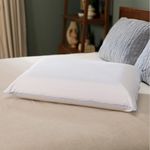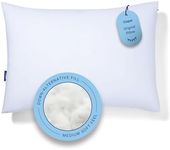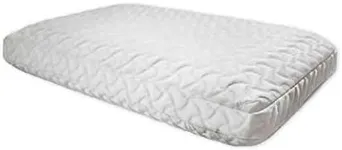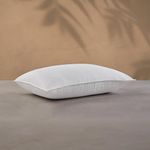Buying Guide for the Best Pillow For Sound Sleeps
Choosing the right pillow is crucial for a good night's sleep. The right pillow can help maintain proper spinal alignment, reduce neck and back pain, and improve overall sleep quality. When selecting a pillow, consider your sleeping position, any specific health concerns, and personal comfort preferences. Here are some key specifications to consider when choosing a pillow for sound sleep.Fill MaterialThe fill material of a pillow determines its feel, support, and durability. Common fill materials include memory foam, down, feather, latex, and synthetic fibers. Memory foam offers excellent support and conforms to the shape of your head and neck, making it ideal for those with neck pain. Down and feather pillows are soft and luxurious but may not provide enough support for some people. Latex pillows are durable and provide good support, while synthetic fibers are hypoallergenic and affordable. Choose a fill material based on your comfort preference and any allergies you may have.
Loft (Height)The loft of a pillow refers to its height or thickness. It is important because it affects the alignment of your head, neck, and spine. Pillows with a high loft are best for side sleepers as they fill the space between the shoulder and head, maintaining proper alignment. Medium loft pillows are suitable for back sleepers, providing adequate support without pushing the head too far forward. Low loft pillows are ideal for stomach sleepers, as they prevent the neck from bending unnaturally. Consider your sleeping position when choosing the loft of your pillow.
FirmnessPillow firmness affects the level of support and comfort. Firm pillows provide more support and are suitable for side sleepers who need to keep their head and neck aligned. Medium-firm pillows offer a balance of support and comfort, making them ideal for back sleepers. Soft pillows are more comfortable and moldable, which can be beneficial for stomach sleepers who need minimal support. Your personal preference and sleeping position should guide your choice of pillow firmness.
SizePillows come in various sizes, including standard, queen, and king. The size of the pillow can affect your comfort and the overall look of your bed. Standard pillows are the most common and fit most pillowcases. Queen and king pillows are longer and provide more surface area, which can be beneficial for those who move around a lot during sleep. Choose a pillow size that matches your bed size and personal preference.
AllergiesIf you have allergies, it is important to choose a hypoallergenic pillow. Hypoallergenic pillows are made from materials that resist common allergens like dust mites, mold, and pet dander. Synthetic fill materials, such as polyester, are often hypoallergenic. Some natural materials, like latex, are also resistant to allergens. Consider your allergy concerns when selecting a pillow to ensure a healthier sleep environment.
Cooling PropertiesSome pillows are designed with cooling properties to help regulate temperature and prevent overheating during sleep. These pillows may use materials like gel-infused memory foam, breathable fabrics, or moisture-wicking covers. If you tend to sleep hot or live in a warm climate, a pillow with cooling properties can help you stay comfortable throughout the night. Look for pillows that advertise cooling features if temperature regulation is important to you.




















